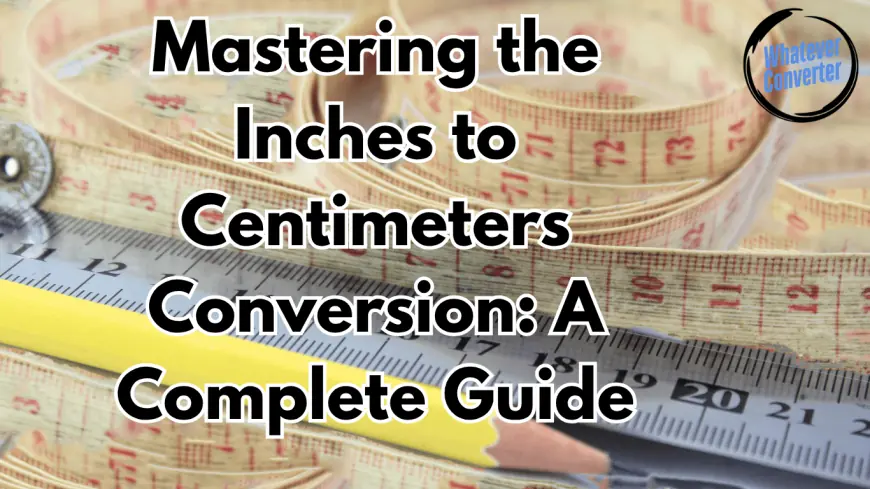Mastering the Inches to Centimeters Conversion: A Complete Guide
Discover how to convert inches to cm with accuracy and ease. This in-depth guide explains formulas, tools, and real-life uses of inch-to-centimeter conversion for daily and professional tasks.

When dealing with measurements, especially in global settings, converting inches to cm becomes a frequent and necessary task. Whether you're crafting a piece of furniture, tailoring clothes, or interpreting product dimensions, understanding how to accurately convert inches into centimeters can make all the difference. Despite being a relatively simple mathematical operation, many still find themselves uncertain when switching between these two common units. This comprehensive guide is here to remove all confusion and help you handle such conversions effortlessly and with confidence.
Why the Inch-to-Centimeter Conversion Matters
Measurement is fundamental to our daily lives, and the need to convert inches to cm spans across many industries, from engineering and construction to fashion and e-commerce. Inches, predominantly used in the United States, coexist with centimeters, a standard unit of the metric system employed nearly everywhere else in the world. This divide can cause miscommunication, errors, and inefficiencies—especially in international dealings.
Imagine ordering a piece of equipment listed in inches while your team uses centimeters. A small miscalculation could result in expensive errors. Similarly, travelers moving between metric and imperial systems need to interpret local road signs, weather reports, and product descriptions. By grasping the principles of conversion, you not only avoid mistakes but also gain a deeper appreciation for precision in measurement.
Understanding the Basics: What Is an Inch and a Centimeter?
Before diving into conversions, it helps to understand what these units actually represent.
An inch is a unit of length in the imperial system, commonly used in the United States, Canada, and the UK for certain applications. It’s officially defined as 1/12 of a foot or exactly 2.54 centimeters. The inch has historical roots that date back to ancient times, often defined by the width of a human thumb.
A centimeter, on the other hand, belongs to the metric system. It’s a subunit of the meter, with 1 meter equaling 100 centimeters. The metric system’s strength lies in its simplicity and base-10 structure, which makes mathematical operations more straightforward.
With the inch fixed at 2.54 cm by international agreement, this creates a consistent and reliable foundation for conversions—perfect for practical application in any context.
The Simple Formula for Converting Inches to Centimeters
At the heart of this conversion lies a very straightforward formula:
Centimeters = Inches × 2.54
Let’s break it down with a few examples:
-
5 inches × 2.54 = 12.7 cm
-
12 inches × 2.54 = 30.48 cm
-
25.5 inches × 2.54 = 64.77 cm
As you can see, multiplying the number of inches by 2.54 gives you the equivalent length in centimeters. This approach works for both whole numbers and decimals, making it universally applicable.
To reverse the process, simply divide the centimeter value by 2.54:
Inches = Centimeters ÷ 2.54
For example:
-
50 cm ÷ 2.54 = 19.685 inches
If you're dealing with large volumes of data or frequent conversions, manually calculating these can be tedious. That’s where online tools like WhateverConverter come in handy, offering fast, accurate results within seconds.
Using Inches to CM in Real Life: Practical Scenarios
Conversions are more than just academic exercises—they play out in countless everyday situations.
1. Online Shopping:
When you’re purchasing clothes or gadgets from another country, you’ll often encounter product sizes in inches. Knowing how to convert inches to cm helps ensure you choose the correct size, especially for items like shoes, monitors, and televisions.
2. Home Improvement Projects:
Whether you're installing shelves, laying flooring, or hanging curtains, precise measurements are crucial. If you're working from US-based tutorials but live in a country that uses the metric system, the ability to switch between units ensures nothing gets lost in translation.
3. Academic and Scientific Work:
Many scientific fields require cross-system accuracy. A lab in Europe may collect data in centimeters, while a collaborating lab in the U.S. uses inches. Having the skills to convert seamlessly supports collaboration and consistency in research.
4. Travel and Navigation:
Maps, road signs, and weather reports vary by country. For example, rainfall may be measured in centimeters while a guidebook may reference inches. The ability to convert quickly helps travelers better prepare for and interpret local information.
The point is, no matter your background, you’re likely to run into situations where converting inches to cm is vital. Mastering this skill can streamline your workflow, enhance communication, and reduce costly errors.
Tools That Make Conversion Effortless
While the math is simple, doing it repeatedly or under time pressure can lead to mistakes. Fortunately, several tools simplify the task:
1. Online Calculators:
Websites like WhateverConverter offer quick and reliable conversions. Just enter the value in inches, hit convert, and get the result instantly. You don’t need to memorize the formula or worry about errors.
2. Mobile Apps:
There are many free apps available for iOS and Android devices that can convert not just inches to centimeters, but a wide range of units. These are particularly useful for on-the-go professionals and travelers.
3. Voice Assistants and Smart Devices:
If you're using a smart assistant like Google Assistant or Siri, a simple command like "Convert 10 inches to centimeters" yields immediate results. This is especially useful when your hands are busy or you're in the middle of a task.
4. Spreadsheet Software:
In Excel or Google Sheets, you can create a custom formula such as =A1*2.54 to automatically convert inch values into centimeters across data sets. This can save valuable time when managing large-scale projects or inventories.
Regardless of your preference, the key is consistency. By integrating these tools into your daily routine, you'll improve accuracy and efficiency in all your measurement-related tasks.
Common Mistakes and How to Avoid Them
Even though the conversion formula is straightforward, there are several common pitfalls to be aware of:
1. Mixing Up the Formula:
It’s easy to forget whether to multiply or divide by 2.54. A good rule of thumb: when converting inches to cm, multiply. When converting the other way around, divide.
2. Rounding Errors:
While rounding may be tempting, excessive rounding can lead to imprecision—especially in technical or construction fields. Always keep a few decimal places unless the context allows approximation.
3. Incorrect Unit Labeling:
Sometimes people write “cm” when they mean “inches” or vice versa. This is especially dangerous when sharing measurements across platforms or teams. Always double-check your units.
4. Ignoring Context:
Not all measurements require exact precision. In design and art, for instance, approximations may suffice. But in mechanical engineering, even a fraction of a centimeter could make or break a project. Knowing when and how precisely to convert inches to cm is just as important as the conversion itself.
By being mindful of these pitfalls, you ensure your measurements are not just accurate but also useful in their intended application.
Building Confidence with Practice and Visualization
Converting inches to cm may seem mundane, but with practice, it becomes second nature. Try actively applying the concept in your surroundings. Measure household items and convert their lengths manually or with a calculator. Use a dual-unit tape measure to familiarize yourself with both systems side by side.
You can also create a reference chart of commonly converted values and hang it in your workspace. Seeing both inch and centimeter values visually aligned helps develop an intuitive understanding of the scale difference.
Moreover, many people find that visualization strengthens their grasp. One inch is slightly longer than 2.5 cm, and knowing this helps you estimate sizes even without a ruler. Over time, you’ll find that you can mentally approximate conversions quickly and accurately—an invaluable skill in many scenarios.
Final Thoughts
Converting inches to cm is more than just a math problem—it’s a practical life skill that empowers you to function smoothly in a globalized world. Whether you're measuring for business, travel, or personal projects, understanding how to convert and interpret these units correctly is essential.
Thanks to the universally accepted conversion rate of 2.54 cm per inch and the availability of tools like WhateverConverter, there’s no reason to be caught off guard. Incorporate conversion tools into your daily workflow, learn from real-world examples, and avoid common mistakes by building a solid understanding from the ground up.
By mastering this simple yet vital conversion, you're equipping yourself with the accuracy and awareness needed to succeed in a measurement-diverse world.
What's Your Reaction?
 Like
0
Like
0
 Dislike
0
Dislike
0
 Love
0
Love
0
 Funny
0
Funny
0
 Angry
0
Angry
0
 Sad
0
Sad
0
 Wow
0
Wow
0




















































